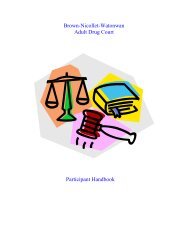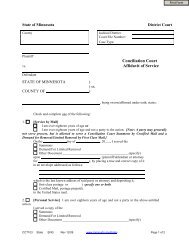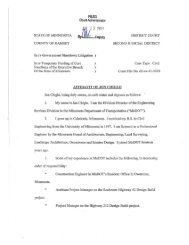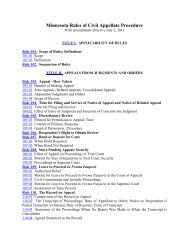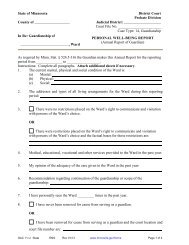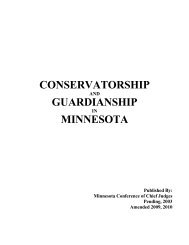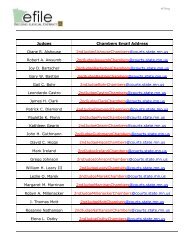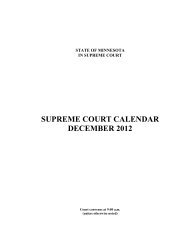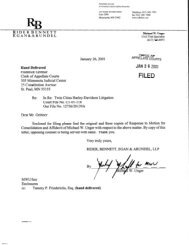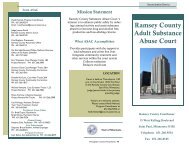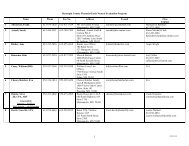1989-03-24 Comments of Star Tribune.pdf - Minnesota Judicial Branch
1989-03-24 Comments of Star Tribune.pdf - Minnesota Judicial Branch
1989-03-24 Comments of Star Tribune.pdf - Minnesota Judicial Branch
You also want an ePaper? Increase the reach of your titles
YUMPU automatically turns print PDFs into web optimized ePapers that Google loves.
I<br />
.<br />
I<br />
I<br />
I<br />
I<br />
I<br />
I<br />
I<br />
I<br />
I<br />
I<br />
I<br />
I<br />
4<br />
I<br />
I<br />
1<br />
I<br />
I<br />
,-..<br />
I<br />
I. INTRODUCTION<br />
FINAL STATISTICAL REPORT<br />
CAMERAS IN THE COURTROOM IN NEVADA<br />
established<br />
courtroom.<br />
In April <strong>of</strong> 1980, the Supreme Court <strong>of</strong> Nevada<br />
an experimental rule governing cameras in the<br />
The rule is referred to as ADKT 26 - Standards <strong>of</strong><br />
Conduct and Technology Governing Electronic Media and Still Photo<br />
Coverage<br />
in effect<br />
<strong>of</strong> <strong>Judicial</strong><br />
for a<br />
Proceedings (See<br />
one-year period:<br />
Attachment<br />
April 1980<br />
A).<br />
to<br />
It has been<br />
April 1981.<br />
A set <strong>of</strong> questionnaires was developed to evaluate the<br />
rule’s effectiveness (See Attachments B, C, D, and E). The<br />
recommendations <strong>of</strong> the Commission were decided upon at its final<br />
meeting,<br />
from the<br />
respectfully<br />
1981.<br />
held May 1, 1981 (See Attachment J). This final<br />
Advisory Commission on Cameras in the Courtroom<br />
submitted to the Nevada Supreme Court on<br />
report<br />
is to<br />
May 7,<br />
II. METHODOLOGY<br />
Evaluation questionnaires were sent to every court in<br />
Nevada. Courts were instructed to return forms after every<br />
proceeding that involved photographic or radio coverage. Four<br />
groups were surveyed: judges, attorneys, media representatives<br />
and witnesses. Twenty-five judges, 17 attorneys, 27 media<br />
representatives<br />
and 31 witnesses responded. In addition to<br />
evaluation forms, reports were received from the Second and<br />
Eighth <strong>Judicial</strong> Districts, the Washoe district attorney and the<br />
Reno Evening Gazette (See Attachments F, G, H and I).<br />
III. SUMMARY OF RESULTS<br />
Result A. The majority <strong>of</strong> judges and attorneys surveyed support<br />
the experimental rule.<br />
As a group, judges are the most supportive <strong>of</strong> the rule,<br />
with 75 percent completely in favor and 11 percent slightly in<br />
favor.<br />
slightly<br />
Seventy<br />
favor<br />
percent<br />
the rule<br />
<strong>of</strong> the<br />
(IV Results,<br />
attorneys<br />
Section<br />
completely<br />
A. Table<br />
favor<br />
1).<br />
or<br />
Result B: Witnesses are least likely <strong>of</strong> the groups surveyed, to<br />
support the experimental rule.<br />
Twenty-six percent <strong>of</strong> the witnesses have no opinion on<br />
allowing media coverage and 45 percent are slightly or completely<br />
opposed to media coverage (IV Results, Section A, Table 1).<br />
Result C:<br />
understand.<br />
According to the media, the rule is fair and easy to<br />
One-hundred percent <strong>of</strong> the media said the rule was verv<br />
or extremely fair. Eighty-six percent said the steps to obtain<br />
permission were extremely or very easy to understand (Results IV,<br />
Section D, Tables 1 and 2).



